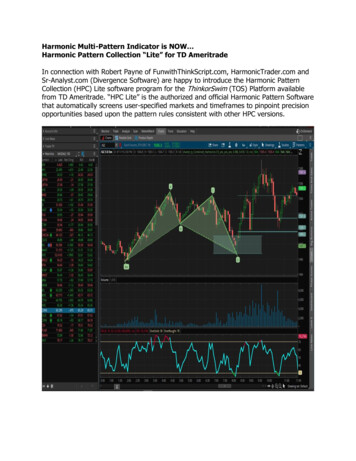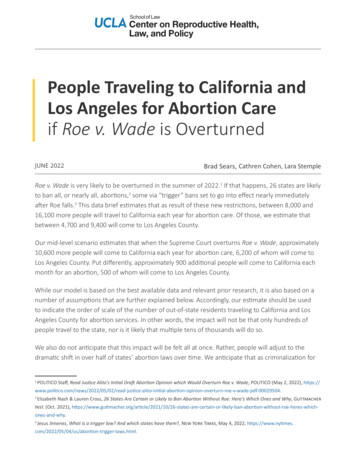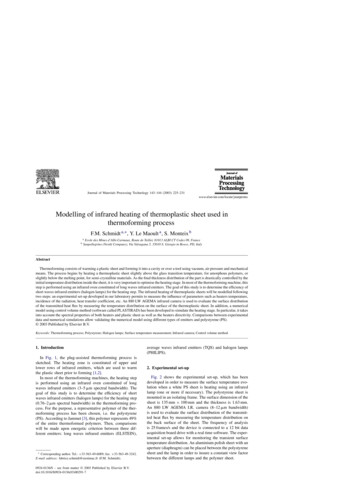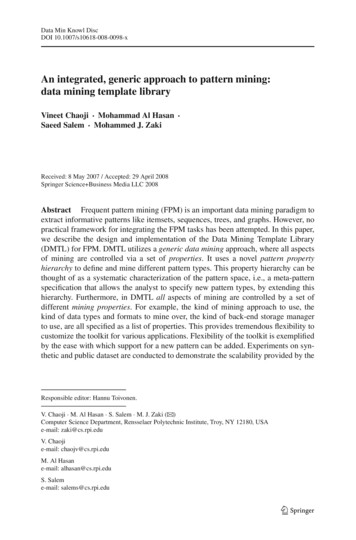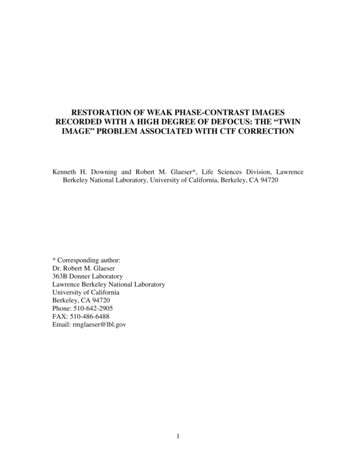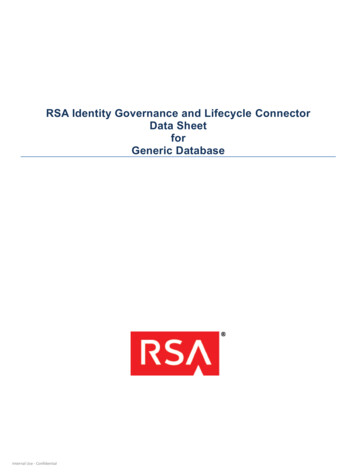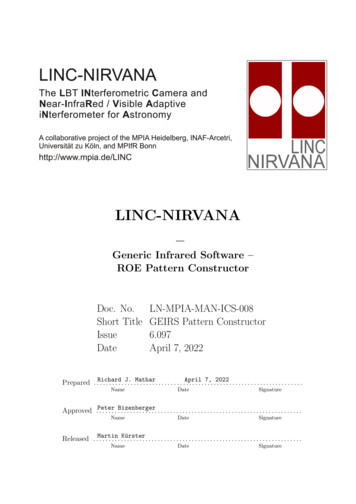
Transcription
LINC-NIRVANA–Generic Infrared Software –ROE Pattern ConstructorDoc. No.Short TitleIssueDateLN-MPIA-MAN-ICS-008GEIRS Pattern Constructor6.097April 7, 2022Prepared . .Richard. . . . . . . . .J. . .Mathar. . . . . . . . . . . . . . . .April. . . . . . .7,. . .2022.NameDateSignatureApproved .Peter. . . . . . .Bizenberger.NameDateSignatureReleased . .Martin. . . . . . . .Kürster.NameDateSignature
iiLN-MPIA-MAN-ICS-008 – GEIRS Pattern Constructor – Issue 6.097Change April 7, createdVersion submitted to the ADPGEIRS SVN version trunk-r799M-65
LN-MPIA-MAN-ICS-008 – GEIRS Pattern Constructor – Issue 6.097iiiContents1 OVERVIEW1.1 Design . .1.2 Interfaces1.3 Acronyms1.4 References.111122 FILE NAMES2.1 Start of Computation .2.2 Conventions . . . . . . .2.3 Cycle Type Conventions2.4 Logging . . . . . . . . .34557.3 File Syntax3.1 Command line expansion . . . . . . . . . . . . . .3.1.1 White Space and Old-fashioned Comments3.1.2 Optional Repeat Count . . . . . . . . . . .3.1.3 Optional Embedded Verbose Comment . .3.1.4 Optional Embedded Timing Evaluation . .3.1.5 Further Comment Removal . . . . . . . . .3.1.6 Do Loop Expansion . . . . . . . . . . . . .3.2 Expressions . . . . . . . . . . . . . . . . . . . . . .3.2.1 State Variables . . . . . . . . . . . . . . . .3.2.2 Automatic Variables . . . . . . . . . . . . .3.2.3 Constants . . . . . . . . . . . . . . . . . . .3.2.4 Operators . . . . . . . . . . . . . . . . . . .3.2.5 Send Expressions . . . . . . . . . . . . . . .3.2.6 Include Expression . . . . . . . . . . . . . .7778888991014141416164 TIMING CALCULATIONS4.1 Aim . . . . . . . . . . . . .4.2 Timers . . . . . . . . . . . .4.3 Subcommands . . . . . . .4.3.1 set . . . . . . . . . .4.3.2 define . . . . . . . .4.3.3 state . . . . . . . . .4.3.4 add . . . . . . . . .4.3.5 on . . . . . . . . . .4.3.6 off . . . . . . . . . .4.3.7 end . . . . . . . . .4.4 Functions . . . . . . . . . .4.4.1 range . . . . . . . .4.4.2 timeof . . . . . . . .1818191919191919202020202020.5 DETECTOR WINDOWS205.1 Principles of Operation . . . . . . . . . . . . . . . . . . . . . . . . . . . . . . . . . . . 205.2 Example . . . . . . . . . . . . . . . . . . . . . . . . . . . . . . . . . . . . . . . . . . . 21
ivLN-MPIA-MAN-ICS-008 – GEIRS Pattern Constructor – Issue 6.0976 PATTERN SCRIPTING6.1 Auto-increment Layer-2 Loops . . . .6.2 Hawaii 2 (i.e., LN) . . . . . . . . . . .6.2.1 RAM Layer Command Format6.2.2 Initial Pattern . . . . . . . . .6.2.3 Disconnected Patterns . . . . .6.2.4 ADC pattern . . . . . . . . . .6.2.5 Idle ReadWoConv . . . . . . .6.2.6 Idle Rlr . . . . . . . . . . . . .6.3 Hawaii-2RG, Hawaii-4RG . . . . . . .6.3.1 RAM Layer . . . . . . . . . . .6.3.2 Initial Pattern . . . . . . . . .6.3.3 ADC pattern . . . . . . . . . .6.3.4 Idle ReadWoConv . . . . . . .6.4 Pattern Examples . . . . . . . . . . .6.4.1 LIR . . . . . . . . . . . . . . .6.4.2 SRR . . . . . . . . . . . . . . .6.4.3 O2DCR . . . . . . . . . . . . .6.4.4 FECR . . . . . . . . . . . . . .7 TROUBLE-SHOOTING7.1 Connectivity . . . . . . . . . . . . . .7.1.1 Linux Driver . . . . . . . . . .7.1.2 Workstation to ROE . . . . . .7.1.3 Data Generator (with 686870File Inclusions . . . . . . . . . . . . . . . . . . . . . .Timing File Inclusions . . . . . . . . . . . . . . . . .Subwindow example (full window) . . . . . . . . . .Subwindow example (detector windows) . . . . . . .Subwindow example (detector windows) . . . . . . .LIR mode (fine scale) . . . . . . . . . . . . . . . . .LIR mode (coarse scale) . . . . . . . . . . . . . . . .SRR mode (fine scale) . . . . . . . . . . . . . . . . .SRR mode (coarse scale) . . . . . . . . . . . . . . . .O2DCR mode (fine scale) . . . . . . . . . . . . . . .FECR mode (fine scale) . . . . . . . . . . . . . . . .Image with open ADC inputs . . . . . . . . . . . . .Test image by the ROE FPGA simulator . . . . . .Hawaii-2 Test image by the ROE data generator . .Hawaii-2RG Test image by the ROE data generator.171822242562636465656769707172.List of Figures123456789101112131415
LN-MPIA-MAN-ICS-008 – GEIRS Pattern Constructor – Issue 6.09711OVERVIEW1.1DesignThe Generic Infrared Software (GEIRS) is a software layer written in C , ANSI-C and Java,which assembles parameter lists and commands received from its own graphical interface or othersupervisor software, translates these into the firmware language (‘patterns’) of the readout electronics (ROE) initializes the readout cycles and accumulates the frames received from the ADC’s of the electronics as FITS files on thelocal disks or X11 images displayed in the engineering GUI.This document summarizes the functionality within GEIRS that scans a textual description ofreadout patterns and emits the codes (lines) that are converted by the firmware to the sequence ofclocks. We coin the phrase pattern constructor to avoid a name clash with pattern generator, whichis the bottom level (the pattern RAM program) of the firmware actually running the detector pins.A design choice of the pattern construction is to split functionality into the scanner and the textualdescription, assuming that the scanner is a kind of virtual representation of the FPGA’s capabilitiesand updated infrequently and co-jointly with that part of the firmware, whereas the patterns areindependently editable by the electronic engineers investigating the characteristics and performanceof the individual chips.That lead to a simple type of programming (interpreter) language for patterns, the grammar ofwhich we describe in this manual. (The noun patterns is perhaps misleading here, as the frameworkis the current interface to Version 3.1 of MPIA’s readout electronics for Hawaii-2, Hawaii-2RG andHawaii-4RG infrared detectors with two FPGA’s, not any generic driver for a state machinery ofarbitrary detector chips.)1.2InterfacesThe document complements the documents on the camera control software [1], ROE [2], readoutpatterns [3], and RoCon [4]. To obtain a full list of the commands understood by the FPGA, pleasecontact the representative electronic engineer of the MPIA.1.3AcronymsADCanalog-to-digit conversionADUanalog-to-digital unitAIPLeibniz-Institut für Astrophysik Potsdam https://www.aip.deANSIAmerican National Standards Institute http://www.ansi.orgASCIIAmerican Standard Code for Information Interchange https://en.wikipedia.org/wiki/American Standard Code for Information Interchange
2LN-MPIA-MAN-ICS-008 – GEIRS Pattern Constructor – Issue 6.097CARMENES Calar Alto High-Resolution Search for M Dwarfs with Exoearths withNear-infrared and Optical Echelle Spectrographs carmenes.caha.esDMADirect Memory AccessFITSFlexible Image Transport System http://fits.gsfc.nasa.govFPGAField programmable gate arrayGEIRSGeneric Infrared SoftwareGUIGraphical User InterfaceIPInternet ProtocolLINCLBT Interferometric Camera http://www.mpia-hd.mpg.de/LINC/LINC-NIRVANA LBT Interferometric Camera and Near-Infrared / Visible AdaptiveInterferometer for AstronomyLNliquid nitrogenLNLINC-NIRVANALUCILBT NIR spectroscopic Utility with Camera and Integral-Field Unit forExtragalactic Research http://www.mpe.mpg.de/ir/luciferMPIAMax-Planck Institut für Astronomie, Heidelberg https://www.mpia.deMPIfRMax-Planck Institut für Radioastronomie, Bonn http://www.mpifr-bonn.mpg.deNIRVANA Near-Infrared / Visible Adaptive Interferometer for AstronomyNTENOT Transit Explorer https://nte.nbi.ku.dk/PANICPanoramic Near-Infrared Camera https://panic.iaa.esPCIePeripheral Component Interconnect Expresshttps://en.wikipedia.org/wiki/PCI ExpressPLXPLX witches-bridges/software-dev-kitRAMRandom Access MemoryRoConReadout ControllerROEReadout ElectronicsSVNSubversion s[1] C. Storz, LINC-NIRVANA - Infrared Camera Control Software, lN-MPIA-FDR-ICS-005(6 Jun. 2005).[2] B. Grimm, U. Mall, LINC-NIRVANA - Readout Electronics for the Science Detector, LNMPIA-FDR-ELEC-001 (21 Jan. 2005).[3] V. Naranjo, LINC-NIRVANA - IR Detector Control Pattern, LN-MPIA-DES-ELEC-007(5 Apr. 2008).
LN-MPIA-MAN-ICS-008 – GEIRS Pattern Constructor – Issue 6.0973[4] J. R. Ramos, ROCON REad-out Controller Board (Nov. 2009).URL webdavs://sk1/geirs/roe3MPIA/Roconv3-Draft.pdf[5] W. Gaessler, LINC-NIRVANA - Software Style Guide, LN-MPIA-MAN-ICS-001 (02 Aug.2004).[6] U. Mall, C. Storz, CARMENES - NIR channel – Readout electronics and software, FDR04C2A. E: in section 2.6.2 the factor 0.5 of the voltage divider is wrong. The actual value forthe CARMENES racks is 0.699. (30 Jan. 2013).[7] C. Storz, V. Naranjo, U. Mall, J. R. Ramos, P. Bizenberger, J. Panduro, Standard modesof MPIA’s current H2/H2RG-readout systems, in: 2012 Astronomial Telescopes and Instrumentation, Vol. 8453 of Proc. SPIE, Int. Soc. Optical Engineering, 2012, p. 2E. doi:10.1117/12.927170.[8] R. J. Mathar, LINC-NIRVANA - Generic Infrared Software, Graphical User Manual, LNMPIA-MAN-ICS-007 (2 Oct. 2018).URL https://www.mpia.de/ mathar/public/LN-MPIA-MAN-ICS-007.pdf[9] U. Mall, LINC-NIRVANA - ROE Schematics, lN-MPIA-TN-ELEC-013 (30 Jan. [10] U. Mall, IR ReadOut Electronics Technical Manual, 1st Edition (Oct. 2014).[11] Teledyne, Hawaii-2RG Technical Manual (25 Sep. 2007).[12] J. R. Ramos, ROCON v3 Upgrade von ROCON v3.0 auf ROCON v3.1 (6 Nov. 2014).2FILE NAMESThe main body of the GEIRS, including the text file parser and communicator with the RoCon, isin the SVN repository https://svn.mpia.de/gulli/geirs/src. The patterns are in the subdirectory pttrns, one per instrument, for example uci for the two LUCI’s. In consequence, adding new features to the parser or any kind of extensions to the syntax described below,and occasionally also modifications of constants requires changes in the C-source code of thecurrent branch plus recompilation; adding new patterns, modifications on the shuffling, insertion/changes of patterns and theirorders and so on can usually be done on the spot by editing the textual representation inthe pttrns subdirectory of the layout and restarting GEIRS. These files are interpreted, notcompiled.Pattern file names usually do not have suffices, so they are for example init pat H2RG and notinit pat H2RG.luci1. The benefit is The output of the directory for example with ls is much easier to read
4LN-MPIA-MAN-ICS-008 – GEIRS Pattern Constructor – Issue 6.097 Cross-linking of patterns that are shared by instruments of the same detector type is easy.One does note need separate files like init pat H2RG.luci1 and init pat H2RG.luci2 butjust one file init pat H2RG, for example.To mechanism in the GEIRS parser to look for a file is: first search for a file with the instrumentsuffix, and if that file does not exist search for the file without the instrument suffix. That meansfor feature tests while testing patterns, the developper can edit/modify a pattern file that has thesuffix and which will be read with priority by the pattern constructor, while the pattern variant ofsome stable (or common) version without the suffix remains in the same directory.Permanent changes anyway require uploading the modifications to SVN. Beware of symbolic links,which share patterns between instruments.If the name of an instrument is changed—for example from Lucifer to Luci1 and from Luci toLuci2—, one would1. add an alias to the enumeration, the new name and the new extension in camtypes.h,2. create a new subdirectory in pttrns reflecting the new name, copy all files of the old directoryto the new one, and switch suffixes in the new pttrns/instru with a script similar to#!/bin/bash# Move all files with suffix .lucifer to files with suffix .luci1for fil in *.lucifer ; dotarg {fil%".lucifer"}.luci1 ;mv fil targdone3. introduce the new CAMERA variable in the scripts/GENERIC and optionally add a new link.Some overview of which exposure times have been calculated is kept in CAMHOME/log/itime*.Detailed accounts of how these intervals accumulate appear in CAMTMP/timing*.log. Softwarestyle and file layout are completely unaware of any LN-specific documented guidelines [5].2.1Start of ComputationThe entry point in the file system where the construction of the pattern starts is roe init chch.extension,where ch denotes the one or two digits of the number of ADC channels in use. For multi-chip cameraslike AIP or CARMENES, this is the number of channels dedicated to each individual chip, and where .extension is optional, .nirvana in our case.The scanner steers the selection of parameters that build tables in the FPGA program by computingfile names from variables that are known to the main parser. The selection of read-out modes andwindow modes, for example, triggers inclusion of a subset of files in the pttrns directory with themechanism detailed later and illustrated in Figure 1. Conceptionally, all supported readout modesare implied by the files in one SVN revision.
LN-MPIA-MAN-ICS-008 – GEIRS Pattern Constructor – Issue 6.0975The effect of scanning the pattern files is immediate. In particular each send command (Section3.2.5) visited in a file interacts with the real hardware of the ROE; if GEIRS had been startedwith the ROE declared in an offline state, a form of software simulation within GEIRS takes over.This software simulator is essentially the only method for a dry-run syntax check of the patternand timing files; it will detect problems with ill-defined variables, missing parentheses and othertypographic errors, but it also is absolutely optimistic assuming that all commands to the ROEthat are constructed would be returning no errors from the firmware.The scanner interprets the pattern files line-by-line. So the contents of files that are not included (by the mechanism of chapter 3.2.6) does not matter. errors in commands sent to the ROE may leave the (partially initialized) ROE in some fuzzystate.For that reason, the communication with the firmware may use a relaxed set of timeouts (seeSection 3.2.5). With that concept of early setup, the read command will start an exposure withminimum time overhead, because this sends a kind of break-interrupt code with a pointer to thenew pattern program to the (micro-processor of the) ROE, only a few tens of bytes via the internet.The delay of this exposure still depends on which type of idle-(break)-mode is currently executedby the firmware.2.2ConventionsThe files named biases with commands in the 900 range contain voltage biases and register settingsfor the infrared chip [4, 6].Files starting roe* are top level commands issued by GEIRS at certain strategic times (power-up,shutdown, re-init,. . . ).Files starting lay* and pat* emit lines for the up to five intermediate layers of the FPGA programand the lowest (RAM) layer. The name pat indicates these are the definitions of the actual patternsbeyond the administrative other layers.The table* files are tables that cross through one or more layers.incl* are sequences in lower levels meant not to be started as a self-sustained program but to beincluded by other files.The timing* files contain basically sets of embedded timing commands, see Section 4.There is no formal difference in the handling of these files. Any file can incorporate other files withthe include mechanism (Section 3.2.6); the variable syntax is the same. Lines within the timing*files that use the timing calculator still need to start with the special comment #!timing to triggersome calculation. In that respect, it is a mere convention and is not syntactically required that theconstruction of the patterns and the timing calculation are kept in separate files.2.3Cycle Type ConventionsAfter an underscore, the standard acronyms of readout modes are often a substring of the file names[7]. The acronyms and the representation in the FITS headers are gathered in Table 1. This list inTable 1 is basically fixed if the file name is computed by expanding the ctype variable (see Section
6LN-MPIA-MAN-ICS-008 – GEIRS Pattern Constructor – Issue 6.097Table 1: Supported GEIRS readout modes. The checked combinations are admitted by the software.shortFITSLN,AIP,PANIC,NTE readXXrrr-mpia rlaced.multiple.successive.read srcontinuous.sampling.readXX
LN-MPIA-MAN-ICS-008 – GEIRS Pattern Constructor – Issue 6.09773.2). The cycle types listed above are a hard-coded list in the current source code, cameratypes.h,and depend on which version of GEIRS is used. The suffix of the file names is instrument specific,here .nirvana, and otherwise .panic, .luci1, .luci2, .carmenes, .nteimg, .ntespec, .sc. Listswith aspects like these contain many entries which may be obsolete for a decade or more and maycertainly change in the future.The read modi (cycle types) offered by the software for a specific instrument (camera) are hardcoded in the function supported ctype in nutil.c as in Table 1.Based on criteria which are not related to software, only the lir with electronic multi-samplingset to 4 and rrr are considered the readout modes for standard LN scientific operations.2.4LoggingThe stream of commands to and responses from the ROE are logged as described in the basemanual [8]. One may watch updates of this file with a GEIRS GUI, which opens a X-terminalexecuting a filtered journalctl on these entries. [8].One may change the log level individually for the object files camsend, camset and camtiming bysending a log command to the interpreter shell—see the command list in the appendix of the GUImanual [8].To aid debugging, the contents of the entries in levels 6 down to level 1 and the ‘pattern’ level mostrecently downloaded to the ROE may be summarized with the command geirs roeDump.pl in thedevel subdirectory. The command is called with a single argument which is the instrument to bedebugged, for examplegeirs roeDump.pl Luci1orgeirs roeDump.pl Panicand prints the patterns send to the RO, eliminating duplicates.3File Syntax3.1Command line expansionInterpretation of the command line is done with the following steps executed in the order documented.3.1.1White Space and Old-fashioned CommentsThe lines in the pattern files may contain comments that are first stripped off the contents: Letters/numbers/strings starting at and including the semicolon (;) up to the end of the lineare discarded. This way of delimiting comments with the semicolon is obsolete and probablyno longer found in any of the pattern files. White space then remaining at the start and/or end of the line is also removed.
8LN-MPIA-MAN-ICS-008 – GEIRS Pattern Constructor – Issue 6.0973.1.2Optional Repeat CountLines that start with the asterisk (*) followed by an (optionally parenthetically nested) integerexpression followed by a second asterisk and more tokens have the expression between the asterisksevaluated. This *.* expression signals a count for a loop over the rest of the line. If the expression evaluates to a negative value, an error is raised. The remainder of the file isnot parsed or executed. If the expression evaluates to zero, this line is effectively not executed, independent of whatremains in the line. if the expression evaluates to a number 1, a repeat count applies to the rest of the line.If the line does not start with a *.* expression, the repeat count is implicitly set to 1.If the expression in *.* evaluates to 1 or 0, i.e., a boolean value, the semantics is equivalent tothe singly branched if-statement of other programming languages.3.1.3Optional Embedded Verbose CommentIf the remaining line now starts either#!verbose onor#!verbose offlogs are sent or not sent to the GEIRS shell that may have been opened by an operator.3.1.4Optional Embedded Timing EvaluationIf the remaining line contains an ‘embedded’ comment of the form#!timing (without spaces), the followup timing expression is evaluated (see Section 4).3.1.5Further Comment RemovalAny characters/numbers/strings starting at a hash (sharp) mark (#) up to the end of the line arediscarded. (At that point the embedded comments of the two formats mentioned in Sections 3.1.3and 3.1.4 are wiped.) Note that removal of the (old) comments started with the semicolon or withthe sharp cannot be masked by means known from other scripting or programming languages.Multiline comments or the C /Java style comments with // are not supported.Another round of removing white space at the start and end of the line follows. If the residual lineis empty, the execution of this line is effectively done and the pattern parser moves on to the nextline in the file. This faith happens to most of the simple free-form comment lines which start justwith the hash.
LN-MPIA-MAN-ICS-008 – GEIRS Pattern Constructor – Issue 6.0973.1.69Do Loop ExpansionIf the command contains a substring of the form do (the white space after the do is mandatory),it is verified whether a repeat count had been found before the do. The repeat count has either thecomputed *.* format described above, including the implicitly defined 1, or is a variable name.If that check fails, an error is raised.The first part of the expression after the do is a blank-separated loop variable—a name without or &. The name is to be unique (as a syntax check of correctly nested loops) and reappears in thelist of known variables (see Section 3.2.1). So the name may be used in arithmetic expressions.1The next expression after the name of the loop variable evaluates to an integer, the loop counter;the remainder of the line is executed as often as requested by this counter. Concepts of individualstart and skip values of the loop variable are not implemented; this is more like a range in Pythonthan the flexibility of a for/while-loop in Fortran/C /Java. (This is a loop executed within theGEIRS scanner simplifying the task of sending similar blocks of FPGA program lines to the ROE.It is not related to the loops in levels 2 and up of the Control-FPGA.)Note that variables in the ‘body’ (after) the do accumulate any changes while looping. (They arepassed by name, not by value.) So their values in any of the loops is whatever has been substituted(left over) by the previous loop.Note also that the (optional) repeat count at the start of the line and the loop counter are twoindependent multipliers. The total number of executions of the expression after the loop counteris the product of both.Do-loops may be nested, so the ‘body’ of the do-loop may contain another do-loop. The nestingis currently limited to 10 levels (see MAXCMDLOOPINFO in camintf.h). This containment typicallyoccurs indirectly by an include command which calls another do-loop.3.2ExpressionsAn expression is evaluated by the following rules: Nested parentheses (.(.).(.).) are evaluated right to left. Improperly nestedparentheses — where a left-to-right scan would find more closing than opening parenthesis— and empty parentheses () result in errors. Assignments have the formatvariable:valueorvariable valueand are also evaluated right to left (if there is more than one).The first format with the colon (:) is an assignment which assumes that the variable has notbeen used before and is generally used to initialize auto-variables (see Section 3.2.2). Thescanner checks that the variable is not known up to that point of the parsing; this helps for1This is equivalent to loop variables in all major programming languages.
10LN-MPIA-MAN-ICS-008 – GEIRS Pattern Constructor – Issue 6.097example to detect cyclic inclusions of files. (This check can be switched off by undefining thepreprocessor variable DEBUG AUTOVAR REASSIGN in camintf.cxx). 2The second format with the sign replaces the value of the variable on the left hand side bythe value on the right hand side. State variables (indicated by a leading ) and auto-variables (indicated by a leading &) aresubstituted in the order right-to-left. The range of the name may be explicitly bound by curlyparentheses of the format {.} or &{.}. This allows ‘computed’ variable names or filenames of the format {.&{.}.}, for example. This is similar to constructs known inTcl, Unice’s shells,. . .The curly parentheses are not needed in general, because names are limited by the next whitespace, the next operator symbol (Section 3.2.4) or the next question mark ?. So &huu*.takes the variable huu and not a variable huu*, for example.3.2.1State VariablesDefinitions (values) of state variables are first searched in files roe variables. extension inpttrns, which is e.g. roe variables.nirvana for Linc-Nirvana, and if the file does not exist inroe variables. The file contains zero or more lines with the following format: The embedded comment #!verbose on or #!verbose off at the start of a line switchesverbosity on or off. Leading white space is ignored. Everything starting with # or ; up to the end of a line is alsoignored (comments). Leftover white space at the start or end of the line is also stripped off. After this comment reduction step, a matching line has the format of the variable name(starting with the ), one ore more blanks, and the substitutional value. (In between thereis neither the colon nor the equal sign.)Variable names are case sensitive. The full name in the file must match, so if searching forabeq1, neither the value in a line starting abeq nor a line starting abeq1o is taken.The substitutional value may still contain embedded blanks. The main application of thisfeature (expressions with interlaced blanks) is to assemble the command and argument linessent to the ROE by simply writing these side by side, separated by blanks, on the same line. If more than one line in the file matches the name, the first match sets the value—in aprinciple of early return from the file.If the variable has not been found in the file, the second search place is the list of loop variableskept in scanner’s state, introduced with a do (Section 3.1.6).If the variable is not a loop variable either, a third fixed list is built into the scanner of the sourcecode (and therefore weakly depending on which GEIRS version is run): adc36 The number of ADC36 boards in the ROE. Default values: 4 for the AIP mosaic,2 for CARMENES and PANIC, 1 for the others. It often is the same as dma, but not forexample for the AIP setup where adc36 is 4 and dma is 2.2C. Storz 2013-05-16: The first format results in an empty string, where the second assignment is delivering theresult to the interpreter
LN-MPIA-MAN-ICS-008 – GEIRS Pattern Constructor – Issue 6.09711 canSrre Boolean value (0 or 1). The 1 indicates that the current ROE and detector typesupport the srre mode, which means that the FPGA on the current ROE supports thecommands related to the uploading of the associated serial registers of the chip and that thecurrent chip type is the Hawaii-2RG or Hawaii-4RG. The main use of this variable is to skipinclus’ion of the pattern files multi* according to the recipe*( canSrre)*include multi win res init chans Number of detector channels (per chip if there is an array/mosaic). These are powersof 2 with a minimum of 1, a maximum of 32 for the Hawaii-2 and Hawaii-
Cross-linking of patterns that are shared by instruments of the same detector type is easy. One does note need separate les like init pat H2RG.luci1 and init pat H2RG.luci2 but just one le init pat H2RG, for example. To mechanism in the GEIRS parser to look for a le is: rst search for a le with the instrument

